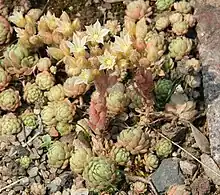| Prometheum | |
|---|---|
 | |
| Scientific classification | |
| Kingdom: | Plantae |
| Clade: | Tracheophytes |
| Clade: | Angiosperms |
| Clade: | Eudicots |
| Order: | Saxifragales |
| Family: | Crassulaceae |
| Subfamily: | Sempervivoideae |
| Tribe: | Sedeae |
| Genus: | Prometheum (A.Berger) H. Ohba |
| Type species | |
| Prometheum sempervivoides (M.Bieb.) H.Ohba | |
Prometheum is a genus of plants in the family Crassulaceae.
Taxonomy
The species in the genus Prometheum include:[1]
- Prometheum pilosum (M.Bieb.) H.Ohba
- Prometheum sempervivoides (Fisch. ex M.Bieb.) H.Ohba
- Prometheum tymphaeum (Quézel & Contandr.) 't Hart
P. sempervivoides and P. pilosum were historically included in genera Sedum (section Cyprosedum), and later Rosularia, but were elevated to a separate genus by Ohba (1995).[2]
Description
According to an experiment done on interspecific plant crosses in the family Crassulaceae, the genus Prometheum produced on average 55 seeds. Furthermore, the same experiment found that plants of the genus Prometheum formed a comparium with each other, meaning they were capable of interbreeding.[3]
Distribution and habitat
References
- ↑ "Prometheum (A.Berger) H.Ohba". Plants of the World Online. The Trustees of the Royal Botanic Gardens, Kew. n.d. Retrieved August 22, 2020.
- 1 2 Ohba 1978.
- ↑ Hart et al 1999.
Bibliography
- Hart, Henk ’t; van Ham, Roeland D.H.J.; Stevens, Jan F.; Elema, Elizabeth T.; van der Klis, Herman; Gadella, Theo W.J. (June 1999). "Biosystematic, molecular and phytochemical evidence for the multiple origin of sympetaly in Eurasian Sedoideae (Crassulaceae)". Biochemical Systematics and Ecology. 27 (4): 407–426. doi:10.1016/S0305-1978(98)00098-2.
- Ohba, H (1978). "Generic and infrageneric classification of the old world sedoideae crassulaceae". Journal of the Faculty of Science University of Tokyo Section III Botany 12(4): 139-193. 12 (4): 139–193.
This article is issued from Wikipedia. The text is licensed under Creative Commons - Attribution - Sharealike. Additional terms may apply for the media files.